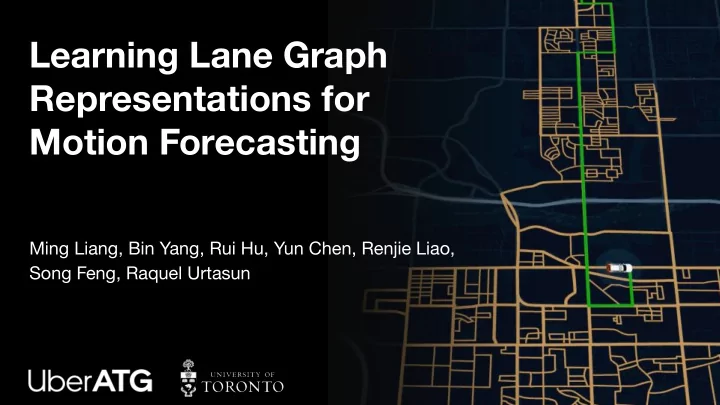

Learning Lane Graph Representations for Motion Forecasting Ming Liang, Bin Yang, Rui Hu, Yun Chen, Renjie Liao, Song Feng, Raquel Urtasun
HD Maps for Motion Forecasting Motion forecasting predicts future trajectories of actors given their past states ● HD maps provide useful clues for motion forecasting ● Behaviors of traffic agents mostly depend on the map topology ○ Interactions of agents are conditioned on maps ○ 2
Related Work: Heuristics Rule-based vehicle & lane association ● Multi-model trajectories with follow-lane assumption ● Drawbacks: ● The vehicle & lane association is error-prone ○ Cannot generalize to complex driving behaviors (e.g., lane change) ○ 3 [1] Making Bertha Drive—An Autonomous Journey on a Historic Route. [J. Ziegler, et al. 2014]
Related Work: Raster Images Lossy rendering of both trajectories and HD map ● 2D convolution on raster images is computation-intensive ● Past Trajectories Map Raster 2D ConvNet Actor-Actor Interaction Predictions HD Map [1] Short-term Motion Prediction of Traffic Actors for Autonomous Driving using Deep Convolutional Networks. [N. Djuric, et al. 2018] 4 [2] ChauffeurNet: Learning to Drive by Imitating the Best and Synthesizing the Worst. [M. Bansal, et al. 2018]
Our Approach: Lane Graph Minimal information loss of map geometry and semantics ● Efficient and effective feature learning on graph-structured data ● Past Trajectories 1D ConvNet Lane-Actor Interaction Predictions HD Map Lane Graph Graph ConvNet 5
Lane Graph: Nodes Raw map data Our lane graph Raw map: ● A set of directed polylines representing the lane centerlines ○ Lane graph: ● Each node represents one directed line segment ○ Preserves full geometric shape, enables fine-grained lane-actor interaction ○ 6
Lane Graph: Edges Raw map data Our lane graph Raw map: ● predecessor, successor, left neighbor, right neighbor 4 connectivity types: ○ Lane graph: ● Multi-type & sparse connectivity between nodes ○ Enables structured information propagation ○ 7
Lane Graph: Node Feature Node feature initialization: ● 8
Lane Graph: Node Feature Update Multi-scale LaneConv: ● Self Left neighbors & right neighbors Multi-scale predecessors & successors 9
LaneGCN: Network Architecture We apply a variant of graph convnet (namely LaneGCN) on the lane graph ● to extract node features LaneGCN architecture: a stack of 4 multi-scale LaneConv blocks ● 10
4-Way Lane-Actor Interactions Actor-to-Lane : Propagate real-time traffic ● information to lane features. For example, if a lane is occupied. Lane-to-Lane : Propagate the traffic ● information along the lane graph. Lane-to-Actor : Fuse the latest lane ● information back to actors. Actor-to-Actor : Interaction between actors. ● 11
Prediction Header 0.2 0.1 Actor feature MLP_regression K trajectories 0.3 0.2 0.1 0.1 MLP_classification K confidence scores Input: actor feature after 4-way lane-actor interactions ● Two branch outputs: ● Regression: output K future trajectories ○ Classification: output K confidence scores conditioned on both actor ○ feature and predicted trajectories 12
Evaluation Results on Argoverse 13
Ablation Study on Modules 14
Ablation Study on Graph Operators 15
Qualitative Comparison on Argoverse Cxx (3rd) uulm-mrm (2nd) Jean (1st) Ours Right turn Wait to turn left 16 Groundtruth Prediction Past trajectory
Qualitative Comparison on Argoverse Cxx (3rd) uulm-mrm (2nd) Jean (1st) Ours Deceleration Acceleration 17 Groundtruth Prediction Past trajectory
Demo 18
Conclusion A new representation for HD maps: ● lane graph A new operator for feature extraction ● on lane graph: multi-scale LaneConv 4-way interactions between lanes and ● actors New state-of-the-art results on the ● Argoverse benchmark 19 Learning Lane Graph Representations for Motion Forecasting. [M. Liang, et al. ECCV 2020]
Recommend
More recommend